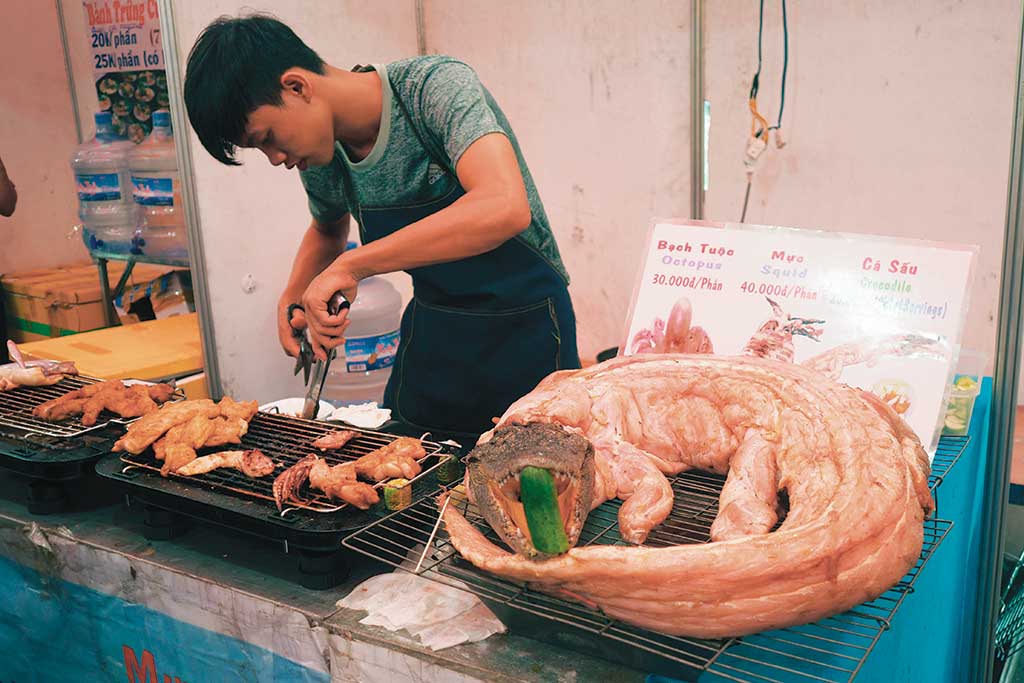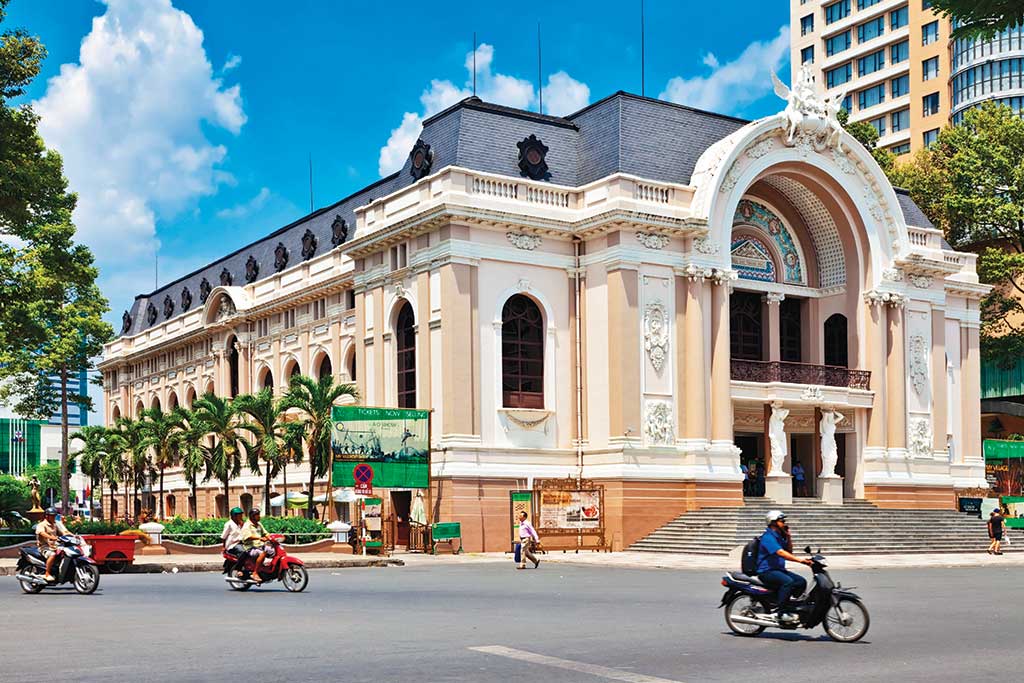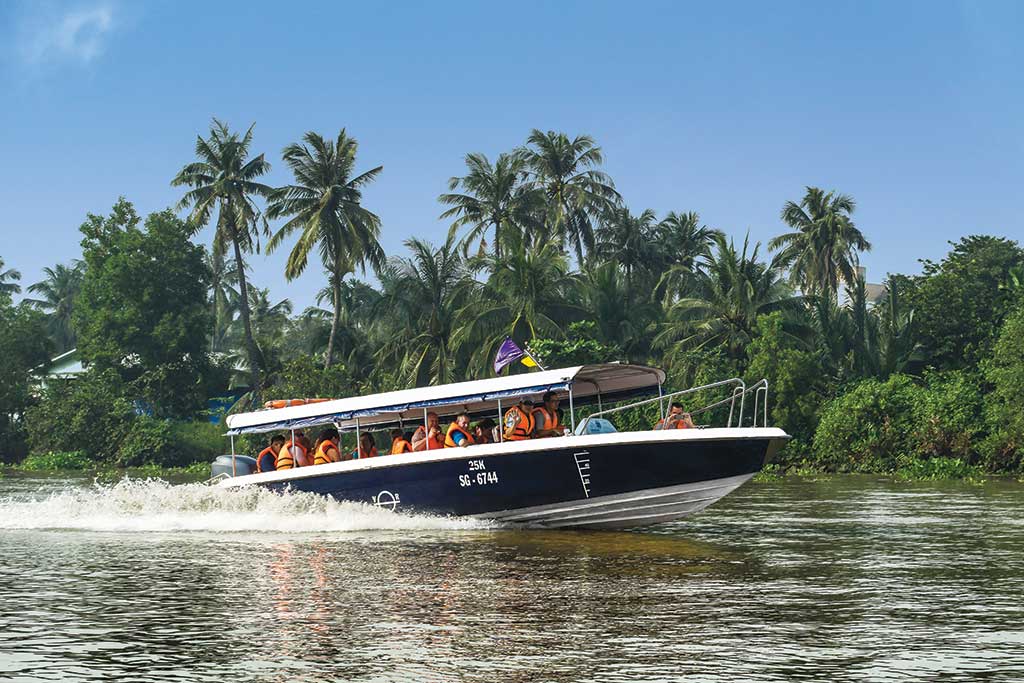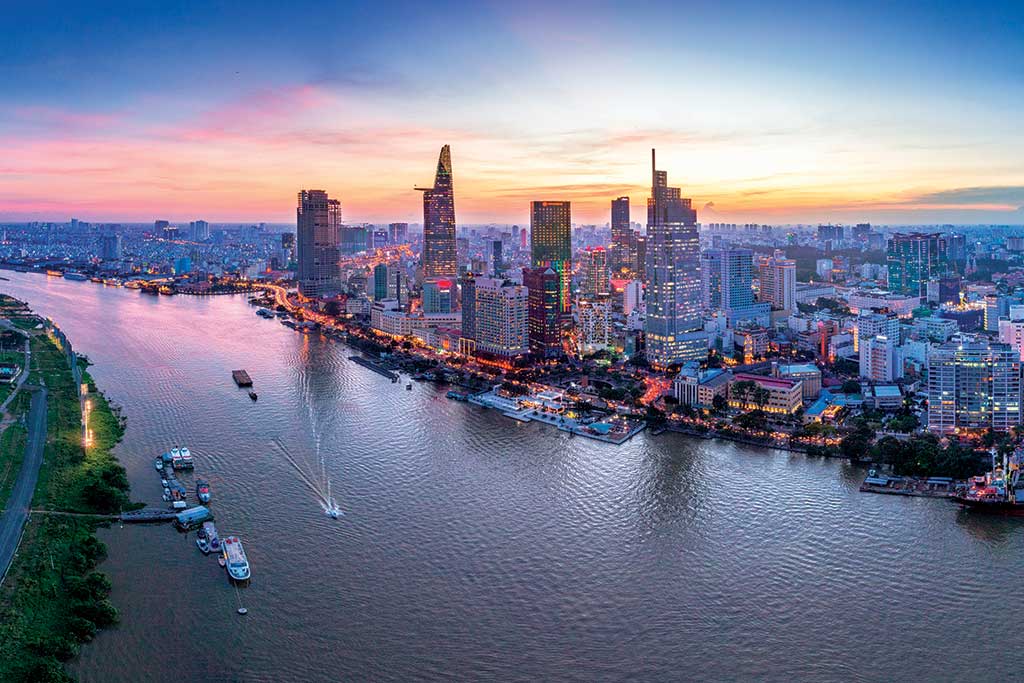As with other modern Asian cities, skybars are popular choices for evening cocktails. The landmark 68-story Bitexco Financial Tower, the tallest building in HCMC, is home to EON51 Heli Bar. Although not technically a rooftop bar (it’s on the 51st floor, part of the buildings distinct UFO-like helipad), this contemporary restaurant and cocktail lounge is more than twice the height of its rival skybars. Also recommended is Above Sky Bar on the 19th-floor rooftop of Liberty Central Saigon Citypoint Hotel. This modern and stylish four-star hotel also has a panoramic top floor swimming pool and its own cinema.
Much of the city’s nocturnal partying is concentrated in an area referred to as the Backpacker District. Focused on the streets and alleys around Pham Ngu Lao, the area is also known for its budget accommodation. Numerous travel agencies also operate here, offering inexpensive tours of the city and beyond.

Crocodile Meat at Street Market
It’s here you’ll find the Pink Tulip Hotel, a small and inexpensive gayrun hotel with a dozen clean, modern, air-conditioned rooms featuring Asian-inspired décor.
Although not a gay bar by Western standards, Thi Bar is a good place to begin exploring. As well as having live music from a singer who blasts out songs by all the divas, from Pink to Adele, this popular little spot in the Backpacker District is frequented by local Vietnamese gays, and reassuringly even had posters for the gay app Blued displayed on its walls.
I had been warned that online listings of gay-frequented venues in HCMC are frequently out of date, something I discovered first-hand when I ended up in another bar with ear-bleeding loud techno music, surrounded by groups of straight Vietnamese teenagers getting smashed on copious beer and vodka shots. The only other gays I spotted here were a bemused gay couple from France who’d seen the same online listing as I had. The best advice is to connect with a local friend to find the current hotspots.
There are also occasional LGBT dance parties by Full Disclosure, featuring a gender-fluid show with Vietnamese drag divas and cute dancing boys (check their Facebook page for latest news). But in truth, if your priority is epic gay nightlife then other destinations in the region such as Thailand, Cambodia, and Taiwan may suit you better.
Another option is to visit one of a handful of gay spas. These include Hero Spa, located close to Ben Thanh Market with sauna, Jacuzzi, relaxing cabins, and a team of handsome male masseurs on hand to provide an array of beauty treatments and services. Located 30 minutes by taxi from the centre of HCMC, the sumptuously decorated Nadam Spa is also recommended.
It would be hard to visit HCMC without contemplating the Vietnam War. American visitors should, however, prepare for the fact that the major tourist sites and museums documenting the war tend to take a distinctly anti-American stance.
The captured American military hardware on display outside of the War Remnants Museum
(including a UH-1 utility military helicopter, an F-5A fighter plane, and an M48 Patton battle tank) at first appear to be boastful war trophies, but with exhibitions covering the indiscriminate effects of the chemical weapon Agent Orange and its ongoing health and environmental impact, the use of napalm bombs, and war atrocities such as the My Lai massacre, it’s soon apparent that this thought-provoking museum doesn’t glorify war, but instead exposes some chilling realities of modern warfare.

Historic Saigon Opera House
Less visceral is the Reunification Palace. This outstanding example of 1960’s architecture was once home to the South Vietnamese president, and is full of groovy period details that could have easily featured in a vintage James Bond movie, including a cinema, a rooftop nightclub, and the allimportant helipad. With its warren of tunnels, war rooms, and offices crammed with retro looking telecommunications equipment, the palace basement has more of a Dr Strangelove vibe. On 30 April 1975, a tank crashed through the palace gates and a soldier entered and unfurled a Vietcong flag from its balcony, signifying the fall of Saigon to the Communists of the north, and what’s fascinating is that the palace has quite simply been frozen in time ever since.
The most popular tourist attraction is the Cu Chi Tunnels, located just over an hour northwest of HCMC by car or bus. This network of underground tunnels, briefing rooms, a field hospital, and dormitories all dug by hand by local villagers were vital when it came to evading the mighty American military. These tunnels also provided the Vietcong with a virtually invisible base of operation from which to fight the Americans with guerrilla warfare. Although American forces used everything from defoliant sprays and firebombs to bulldozers, attempts to flush out the tunnel-dwelling resistance fighters proved ineffective. Ultimately, the resilience of the tunnels helped to prove to America that the Vietnam War was unwinnable.
Before touring the site, visitors sit through an awkwardly one-sided propaganda video detailing the actions of “American devils,” edited together from scratchy old black-and-white footage. You’ll loose count of how many times the phrase “kill Americans” is spoken, with examples including a fresh-faced teenage girl who earned respect for the number of US GIs she killed, earning her the “Championship Title of Killing American Soldiers.”
Although the likes of Donald Trump may feel obliged to take this personally and respond with a Twitter storm of reactionary protest against the anti-American rhetoric, the Cu Chi Tunnels are a place for remembering history and respecting all those who lost their lives on every side, rather than a place to rekindle a napalm firestorm of fury.
Ho Chi Minh City is also the gateway to the fascinating Mekong Delta. This region can easily be explored in a variety of different ways. A host of organized tours depart from HCMC. There are tours to suit all budgets, but typically they begin with a bus transfer to the town of My Tho, and incorporate a boat tour, sampan ride, and a traditional Vietnamese lunch.
One tour company to offer something different is Les Rives. Rather than being stuck in a traffic jam of tour buses slowly heading toward My Tho, Les Rives provide the opportunity to tour the Mekong Delta by speedboat, which means you depart by boat directly from Ho Chi Minh City pier. As well as making you feel super-jetset, the speedboat provides the freedom to explore areas of the Mekong Delta that few other tourists get to see.
Zipping along the jungle-fringed canals of the Mekong Delta, leaving the hustle and bustle of HCMC behind in our wake, it was fascinating to see more traditional and authentic examples of Vietnamese life.

Touring the Mekong Delta by Speedboat
The tour itinerary included a traditional Buddhist pagoda, a flamboyant Cao Dai Temple, and a lively riverside market where stallholders sell all kinds of exotic and unfamiliar produce. Other tour highlights included a stop at a rural Vietnamese house set amid acres of tranquil farmland, but we hadn’t just come to admire the lovely view, we’d come to sample their homemade Mekong whisky. Downing a shot of fiery and potent Mekong whisky helped prepare us for our next stop, because the next Vietnamese house we visited was home to a truly gigantic python. The family explained that they’d reared it from infancy and it posed no threat, but I still declined the chance of a photo-op with this slithery 132-pound snake draped around my shoulders like a feather boa (I’d only had the one shot of whisky, after all!).
Other tours offered by Les Rives include an eco-adventure to the dense mangrove forests of the Can Gio UNESCO Biosphere Reserve, to see wildlife such as monkeys, gibbons, and crocodiles. It’s also possible to take a two-day Mekong Delta speedboat tour with Les Rives, including overnight accommodation at The Island Lodge, a boutique hotel with stylish Indochinese décor, and a dramatic infinity pool overlooking the Mekong.
Ultimately it’s rewarding to see HCMC and the Mekong region thriving just a few decades after the Vietnam War, and although war tourism may have kickstarted the country’s tourist industry, it’s great to see that Vietnam has so much more to offer.
One can only hope that other cities we have come to associate only with conflict, such as Kabul in Afghanistan and Aleppo in Syria, will in time rise from the ashes, emerging from the shrapnel-scarred shadows of war to become places that are featured on the travel pages of glossy magazines, and not as tragic front-page news. Mafu


